Delaware • New Jersey • Pennsylvania
New York • United States of America
- Aquatic Life Designated Use Project
- Bacteria Monitoring
- Biomonitoring Program
- Chlorides Monitoring
- Contaminants of Emerging Concern
- Delaware Estuary Water Quality Monitoring Program
- Dissolved Oxygen and Nutrients
- Modeling
- Other Monitoring (e.g., Toxicity, Fish Tissue, Metals)
- PCBs and PMPs
- Special Protection Waters (SPW)
- Water Resource Data Sets
- Introduction
- PFAS Monitoring in the Delaware River Basin
- Reports & Presentations by DRBC
- Related Resources
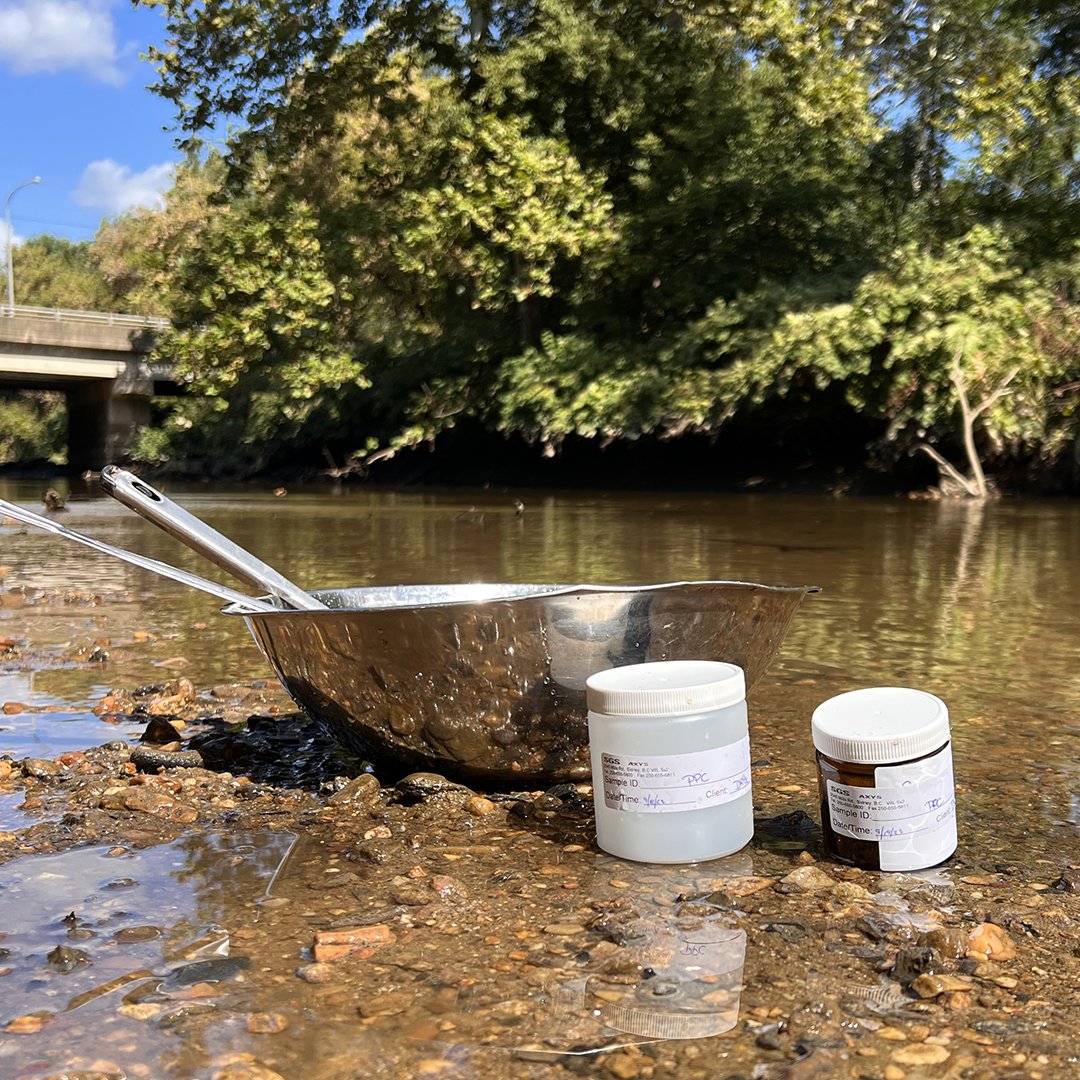 |
| A photo of water and sediment samples collected from the Pennypack Creek. Photo by the DRBC. |
What are PFAS?
Perfluoroalkyl and polyfluoroalkyl substances (PFAS) are a diverse group of >13,000 chemical compounds that have varying degrees of persistence, toxicity and bioaccumulation in the environment.
Known as "forever chemicals," they also do not easily degrade.
The most produced and studied of the PFAS are Perfluorooctanoic acid (PFOA) and Perfluorooctanesulfonic acid (PFOS).
PFAS have unique properties to repel both water and oil. They are found in a variety of industrial and household products, including:
• Fire-fighting foams
• Nonstick cookware, paper coatings & food packaging
• Stain repellent & waterproof textiles (clothing, furniture, carpet)
Exposure to PFAS
In addition to direct human exposure pathways, PFAS can enter the environment through industrial outfalls, municipal treatment plants, firefighting foams, stormwater runoff and landfill leachate.
PFAS released into the environment can contaminate surface water, as well as groundwater, and can bioaccumulate in fish. Environmental releases expose wildlife and humans through direct (swimming, drinking water, etc.) and indirect (consumption of contaminated organisms, etc.) pathways.
With PFAS' ubiquitous nature, there is increasing evidence of its adverse effects on human health and the environment.
Setting PFAS Drinking Water Criteria: States and EPA
PFAS have been detected in drinking water. To manage and reduce PFAS exposure, the Basin states and the EPA have implemented health advisories, drinking water standards and fish consumption advisories.
- U.S. EPA: In 2024, the EPA announced the final National Primary Drinking Water Regulation (NPDWR), setting maximum containment levels (MCL) for six target PFAS compounds. This rule requires public water systems to monitor these compounds, notify the public of their concentrations and reduce levels that exceed the proposed standards. Click the link to learn more about the current status of this rule.
- New Jersey, Pennsylvania and New York: These states have PFAS drinking water standards for two to three compounds, but they are all higher than the proposed EPA limits.
- Delaware: Delaware has its own PFAS Action Plan based on the proposed EPA MCL drinking water standards.
 |
| DRBC staff pull a sediment sample from the Delaware River to monitor for PFAS. Photo by DRBC. |
It is important to quantify PFAS occurrence and bioaccumulation to protect water resources that are vital to ecosystem and human health.
• DRBC has investigated PFAS in Delaware River fish tissue since 2004, in surface water since 2007 and in sediment since 2016.
• DRBC works with the Basin states, EPA and others to understand and manage these contaminants of emerging concern.
• DRBC also works with its Toxics Advisory Committee (TAC), Monitoring and Advisory Coordination Committee (MACC) and Water Quality Advisory Committee (WQAC) to solicit input from experts and stakeholders in the Basin on how to improve its monitoring program.
Why does the DRBC Collect PFAS Data?
• To identify occurrences and potential sources of PFAS;
• To understand risks to designated uses (e.g., source water protection, fish consumption advisories, maintenance and propagation of fish and other aquatic life); and
• To evaluate the efficacy of regulatory and reduction management strategies in reducing exposure and risks from PFAS.
DRBC Monitoring Efforts
- The DRBC has performed PFAS monitoring of surface water, sediment, fish tissue and blue crab tissue under several different grant projects.
- Fish species collected are channel catfish and white perch from the tidal Delaware River and white sucker and smallmouth bass from the non-tidal Delaware River.
Delaware River Conservation Fund (NFWF)
- In 2021 and 2022, the DRBC collected samples of surface water, sediment, fish and blue crabs to monitor for 40 different analytes of PFAS in the mainstem Delaware River at seven locations from Lackawaxen, Pa. in the upper Delaware to Pea Patch Island, Del. Five tributaries were also sampled, including the Neshaminy Creek and the Lehigh, Schuylkill and Christina rivers.
- Data collected show a general trend of increasing PFAS concentrations from upstream to downstream, likely due to increasing population, commercial and industry densities as you head towards Pea Patch Island in the Delaware Bay.
- In July 2023, the DRBC published PFAS Water Quality and Fish Tissue Assessment Study: Year 1 (pdf).
- In 2023, 15 main stem sites from Lackawaxen, Pa. to Pea Patch Island, Del. and 1 tributary (Schuylkill) were sampled for water and sediment and 9 sites for fish and 1 for blue crabs. Forty different analytes of PFAS were monitored for, and samples were collected in the spring and fall.
- In March 2024, the DRBC published PFAS Water Quality and Fish Tissue Assessment Study: Year 2 (pdf).
- The Year 3 study report under this grant is forthcoming.
PA Coastal Zone Management (PACZM)
- This work was financed, in part, through a Federal Coastal Zone Management Grant, administered by the PADEP and funded by NOAA.
- For Year 1 of this grant, the DRBC was able to monitor 17 total sites, 10 in the mainstem Delaware River Estuary bordering Pennsylvania and 7 in Pa. tidal tributaries, near their confluence with the Delaware River. Over 40 different PFAS compounds were monitored for. The same general trend of increasing PFAS concentrations from upstream to downstream, likely due to increasing population, commercial and industry densities, was seen.
- In July 2023, the DRBC published PFAS in Surface Water, Sediment and Fish in the Pennsylvania Coastal Zone (pdf) for year 1 of the project.
- In 2023, monitoring for Year 2 of this grant collected sediment and surface water samples at 17 sites in the tidal Delaware River and adjacent Pa. tributaries. Collection of fish tissue at 6 sites occurred in October 2023 and May 2024.
- In July 2025, the DRBC published Characterization of PFAS in Surface Water, Sediment and Fish in the Pennsylvania Coastal Zone (pdf) for year 2 of the project.
- DRBC Blog about Report Publication (July 2025)
Partnership for the Delaware Estuary (Bipartisan Infrastructure Law)
- In 2023, thanks to grant funding from the Bipartisan Infrastructure Law that came to the DRBC through the Partnership for the Delaware Estuary, surface water from 12 tidal tributaries were sampled from south of Trenton, N.J. to Delaware.}
- Parameters sampled for included PFAS, PCBs, Dioxins, Furans, Organochlorine Insecticides, Neonicotinoid Insecticides, Pyrazole Pesticides and PAHs.
- The DRBC found some level of pollution from each group of chemicals analyzed at each tributary, although the amounts varied.
- Future work will help track down the sources of these pollutants in tributaries, which contribute to pollutants in the mainstem Delaware River.
- Enhanced Monitoring for Toxics and Emerging Contaminants in Delaware Estuary Tributaries (Final Report; pdf; April 2025)
- DRBC Blog about Report Publication (April 2025)
N.J. Water Supply Authority: Delaware & Raritan Canal
- In the spring 2024, the DRBC deployed passive samplers in the D&R Canal (in both the DRB and Raritan Basin) to help the N.J. Water Supply Authority determine sources of PFAS in the canal. The canal is a source of drinking water. Initial results show higher PFAS concentrations in the Raritan portion of the D&R Canal than in the DRB.
What Do the Data Show to Date?
- PFAS concentrations generally increase from upstream to downstream, likely due to increasing population, commercial and industry densities.
- Concentrations of PFAS in resident fish varied by species, sample location and sample year.
- Surface water concentrations of PFAS appear to be below regional and national guidelines in areas designated as drinking water sources.
- While significant decreases in some PFAS compounds have been observed in fish species, reduction in concentrations of other PFAS, such as PFOS, in fish tissue has been less substantial and has triggered fish consumption advisories in Basin states.
- Sediment from the tidal main stem Delaware River have long-chain PFAS detected at low concentrations.
- Further evaluation of risk to human health and wildlife is warranted in the Delaware River.
Long-term Roadmap
- With ~20 years of monitoring, the DRBC's PFAS dataset is extensive. Data have also been collected by USGS and the EPA. DRBC's next steps include building a dataset for all publicly available PFAS data in the Basin. These data will be used to assess PFAS presence and hotspots, as well as inform any management action DRBC could take to reduce PFAS in the Delaware Basin.
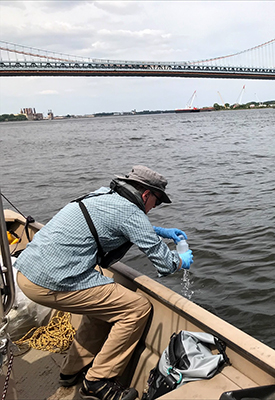 |
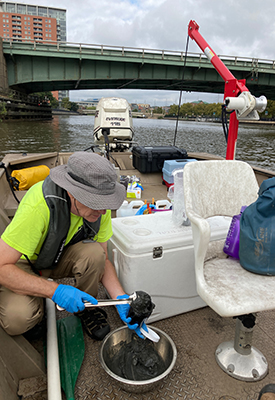 |
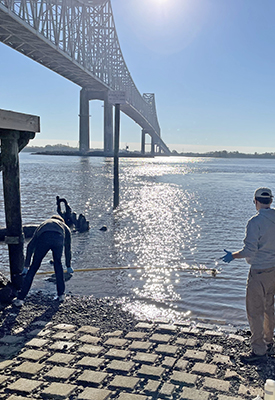 |
| DRBC staff collects a surface water sample from the Delaware River to monitor for PFAS. Photo by DRBC. |
DRBC staff collects a sediment sample from the Delaware River to monitor for PFAS. Photo by DRBC. |
DRBC staff collects a surface water sample from the Delaware River to monitor for PFAS. Photo by DRBC. |
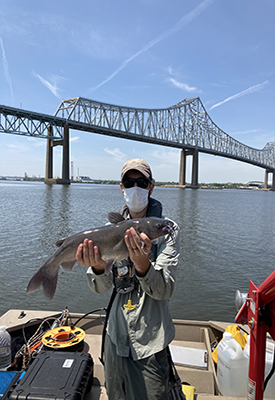 |
 |
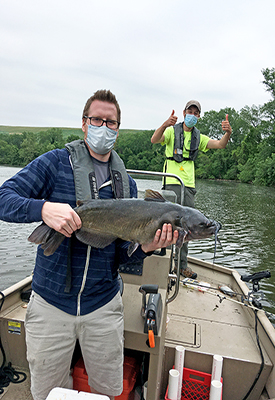 |
| DRBC staff collected several species of fish, including catfish, from the Delaware River to monitor for PFAS. Photo by DRBC. |
DRBC staff collected blue crabs from the Delaware Bay to monitor for PFAS. Photo by DRBC. |
DRBC staff collected several species of fish, including catfish, from the Delaware River to monitor for PFAS. Photo by DRBC. |
Reports/Publications
- Characterization of PFAS in Surface Water, Sediment and Fish in the Pennsylvania Coastal Zone (pdf; July 2025)
- Enhanced Monitoring for Toxics and Emerging Contaminants in Delaware Estuary Tributaries (pdf; April 2025)
- Per- and Polyfluoroalkyl Substances (PFAS) in Urbanized Section of the Delaware River Watershed: Risk Assessment and Geographical Distribution (pdf; March 2025 paper co-authored by DRBC staff. Full citation: Akbari, E., Shah, T., Nazaruk, K. et al. Per- and Polyfluoroalkyl Substances (PFAS) in Urbanized Section of the Delaware River Watershed: Risk Assessment and Geographical Distribution. Water Air Soil Pollut 236, 192 (2025). Online: https://doi.org/10.1007/s11270-025-07835-0)
- PFAS Water Quality and Fish Tissue Assessment Study: Year 2 (pdf; March 2024)
- PFAS Water Quality and Fish Tissue Assessment Study: Year 1 (pdf; July 2023)
- PFAS in Surface Water, Sediment and Fish in the Pennsylvania Coastal Zone (Technical report authored by DRBC staff and financed, in part, through a Federal Coastal Zone Management Grant, administered by the Pennsylvania Department of Environmental Protection; pdf; July 2023)
- Temporal Trends of Per‐ and Polyfluoroalkyl Substances in Delaware River Fish, USA (September 2020 paper authored by DRBC staff published in Integrated Environmental Assessment and Management, 2021;17:411–421. Full citation: MacGillivray, A.R. (2021) Temporal trends of PFAS in Delaware River Fish, USA. Integrated Environmental Assessment and Management. 17(2) 411-421)
Presentations Given
- Penn State Extension Water Cooler Talk: PFAS & 6-PPDq in the Delaware River Basin (pdf; given in August 2025)
- Long Term PFAS Monitoring in the Delaware River and Tributaries (pdf; given at the February 2025 PDE Science Summit)
- DRBC's Toxics and Research Planning (pdf; presentation given to the Toxics Advisory Committee; February 2024)
- Per- & polyfluorinated alkyl substances (PFAS) in Pennsylvania surface waters: a statewide assessment & associated sources (pdf; presentation given to the Toxics Advisory Committee by Sara E. Breitmeyer, USGS; February 2024)
- DRBC PFAS Monitoring and Collaborators in the Delaware River Basin (pdf; presentation given at the Mid-Atlantic Source Water Protection Leadership Forum; November 2023)
- DRBC Project Updates (pdf; presentation given at the DRBC TAC Meeting; June 2023)
- DRBC PFAS Monitoring Update (pdf; presentation given at the DRBC TAC Meeting; June 2022)
- PFAS in Surface Water, Sediment and Fish from the Delaware River (pdf; presentation given at the SETAC Regional Spring Meeting; April 2022)
- PFAS in Surface Water, Sediment and Fish from the Delaware River (pdf; presentation given at the DRBC TAC Meeting; January 2022)
- PFAS in Surface Water and Fish (pdf; presentation given at a webinar "PFAS Uses and Alternatives," hosted by the Northeast Waste Management Officials' Association; April 2021)
- PFAS Monitoring (pdf; presentation given at the DRBC TAC Meeting; January 2021)
- PFAS in Surface Water, Sediment, and Fish from the Delaware River (pdf; presentation given at the 2019 NJWEA Conference)
- PFAS in Surface Water, Sediment, and Fish from the Delaware River (pdf; presentation given at the AWRA Annual Conference; November 2018)
- PFAS in Surface Water and Fish Tissue from the Delaware River (pdf; presentation given at the American Chemical Society's (ACS) National Meeting and Exposition; August 2016)
- Summary Video of PFAS Presentation (mp4; video courtesy of ACS Scientific Video Lab)
- Summary Video of PFAS Presentation (mp4; video courtesy of ACS Scientific Video Lab)
- Perfluorinated Chemicals: Emerging Drinking Water Contaminants (pdf; Presented by Gloria Post, Ph.D., DABT, N.J. Dept. of Environmental Protection, at the DRBC TAC Meeting; June 2013)
- PFCs in Fish Tissue in the Delaware River (pdf; presentation given at Nov. 2009 National Forum on Contaminants in Fish)
- Agency for Toxic Substances and Disease Registry (ATSDR): PFAS and Your Health
- American Water Works Association: PFAS - Contaminants of Emerging Concern
- Aqua America: Water Facts
- Association of State Drinking Water Administrators: PFAS
- Delaware Dept. of Natural Resources and Environmental Control: PFAS
- Department of Defense: Naval Air Station Joint Reserve Base: Willow Grove
- Environmental Working Group: PFAS Contamination in the U.S.
- Interstate Technology and Regulatory Council: PFAS
- National Institute of Environmental Health Sciences: PFAS
- New Jersey Dept. of Environmental Protection: PFAS
- NJDEP: Drinking Water Facts - PFAS in Drinking Water (pdf)
- New York State Dept. of Environmental Conservation: PFAS
- Pennsylvania Dept. of Environmental Protection (PADEP): PFAS
- PADEP: Anglers Warned to Not Eat Fish from Neshaminy Creek Basin: Perfluorooctane Sulfonate (PFOS) risk from all species (October 13, 2021)
- PFAS Project Lab: Studying Social, Scientific and Political Factors of Per- and Polyfluoroalkyl Substances
- Philadelphia Water Department: PFAS
- US Environmental Protection Agency (USEPA): PFAS
- USEPA: PFAS Analytic Tools
- USEPA: Drinking Water Health Advisories for PFOA and PFOS
- USEPA: PFAS Strategic Roadmap
- USEPA: Technical Fact Sheet – Perfluorooctane Sulfonate (PFOS) and Perfluorooctanoic Acid (PFOA)
- USGS: Integrated Science for the Study of Perfluoroalkyl and Polyfluoroalkyl Substances (PFAS) in the Environment—A Strategic Science Vision for the U.S. Geological Survey (2021)
- USGS: Groundwater Withdrawals & Regional Groundwater-Flow Paths near Willow Grove & Warminster, Bucks & Montgomery Counties, Pa. (presentation given at Feb. 2020 DRBC WMAC meeting; pdf)
- USGS & PADEP Research Paper: Per- and polyfluorinated alkyl substances (PFAS) in Pennsylvania surface waters: A statewide assessment, associated sources, and land-use relations (2023)
Copyright © Delaware River Basin Commission,
P.O. Box 7360, West Trenton, NJ 08628-0360
Phone (609)883-9500; Fax (609)883-9522
Thanks to NJ for hosting the DRBC website